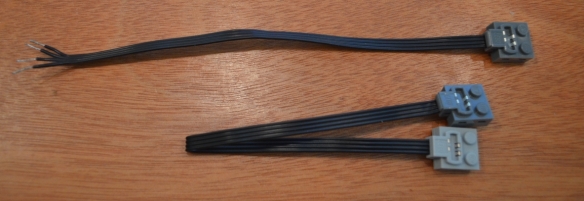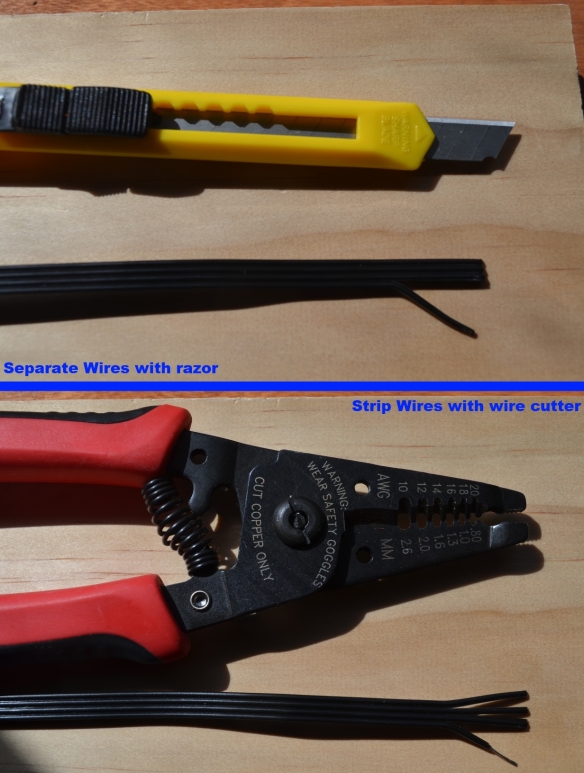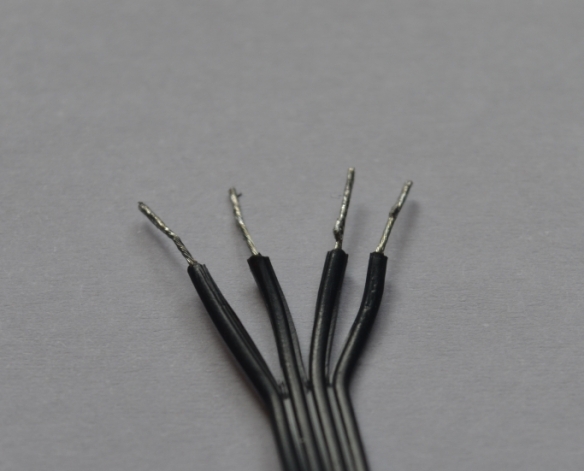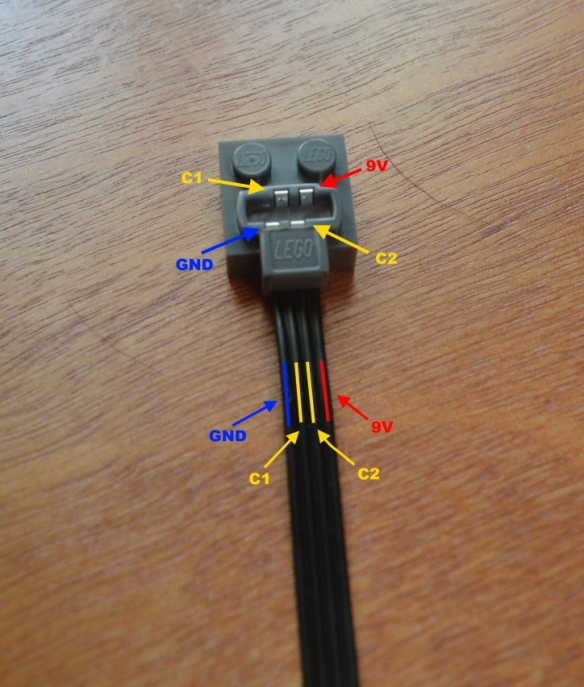Lego Power Functions Hacking Guide – Part 3 – Wire Hacking
Part 1 – Introduction
Part 2 – Equipment
Part 3 – Wiring Hacking
Part 4 – Wiring Arduino (coming soon)
Its time to hack! Break out the wire cutters and soldering irons cause its about to get real.
Step 1 – Grab your LEGO PF extension cables
The first thing we will need to do is prepare our extension cables so that one end can be hooked up to our legos and the other can go in to a breadboard for attachment to Arduino and motor controller.
As you can see in the picture above the extension wires have two different colored heads on them, one light grey and one dark grey. We’re going to cut off the light grey end as close as possible to the plastic head to leave as much wire as we can. (Side note: the underside of the light grey end converts PF to old Mindstorms motors which is why we are cutting off that end). The goal is to achieve what you see with the top wire in the picture. A LEGO connector on one end and bare wires on the other.
Step 2 – Cut and Strip the wires
As mentioned above, take your extension cable and cut light grey end off as close to the plastic as possible. You should come out with the four wires that make up the cable all stuck together by their insulation. Now we need to prep the wires for use with a bread board
The first thing is to separate each of the four wires from each other using a razor or utility knife to cut the areas between each wire’s insulation. The insulation is thin so you have to be careful to stay straight and not bite in to a wire. I find this easiest by laying the blade edge flush with the area to be cut and then pushing straight down to do the cut all at once.
Next you need to strip the separated wires of their insulation. I used a wire stripper that can do 22 gauge stranded wire (20 gauge solid). I highly recommend a wire stripper as seen in the picture as the wire is very small and stranded which makes it easy to cut off strands when doing it with a razor blade.
Step 3 – Tin the wires and do it again for a second cable!
The final step is to tin the wire ends. This means to use a soldering iron to apply a small amount of solder to the end and bind the strands all together. This makes is much much easier to insert the wires in to a solder-less breadboard for use with the Arduino. You should end up with an end that looks something like the picture below. For help with Tinning do a search on youtube as there are many examples. We will need two of these cables so make sure you complete a wire in the exact same way.
Step 4 – Know your wires!
Congratulations! You have two wires hacked and ready to go (hopefully). Now we need to learn a little something about what each of the four wires does. In the picture below I have labeled each of the four wires from the top view of the cable (Lego nubs facing up on the connector)
Power Functions Wires:
- GND – ground wire – Always connected (0V regardless of battery pack direction)
- C1 – control wire 1 – 9V when battery pack is forward, 0V when in reverse
- C2 – control wire 2 – 0V when battery pack is forward, 9V when in reverse
- 9V – power wire – On when battery pack is on (9V regardless of pack direction)
The two outside wires are our power and ground. Anytime a LEGO battery pack is connected and turned on these wires will be the same and do not change polarity. The two inside wires are the motor control wires that power the motors themselves. When a battery pack has its direction switch changed it reverses the polarity of these two. When C1 is high and C2 is low the motors rotates forwards. When C1 is low and C2 is high the motor rotates backwards. If you have a PF infrared speed controller in your system the speed controller applies a PWM signal to C1 or C2 to regulate the speed.
Step 5 – Our design
What we are going to do is use one of our cables to draw power from the LEGO battery pack via the outside two wires and then use our second cable with the inside two wires to attach the PF motor to our motor controller. Stay tuned for how to wire this up with the Arduino!
Guide Table of Contents
Part 1 – Introduction
Part 2 – Equipment
Part 3 – Wiring Hacking
Part 4 – Wiring Arduino (coming soon)






Nice to meet you the other day at Radio Shack. Looking forward to future articles!
Many thanks for sharing your insights in lego hacking. This is very appreciated.
I am eagerly awaiting Part 4. When can we expect it to be online?
Best regards,
Tamidor
Hi Tamidor!
I’ve been really busy with my 3D Printer build (which will probably have a post about soon) so I’ve neglected my duties in finish the Lego series. Glad you called me out so I remember to get back to it! I have all the code and circuits together, I just need to finish the wiring diagrams. I was looking for a program to create circuit diagrams that showed on a virtual breadboard and I think I recently found one in “Fritzing” (http://www.fritzing.org). I’ll try to get around to it soon here (week or two maybe) to close out the major section with a working code file and circuit. I have future plans to also include a 3D printable model that will let you mount the Arduino UNO to a Lego platform. A Lego train car in my case, but that will probably be quite a while out as tune my printer and get better at Open SCAD which I am using to create my 3D Models.
In the mean time, feel free to email me at scuttlebots@gmail.com with questions or any project help!
Thank you for your reply!
I am quite new to the arduino. My goal is to build a programmable lego robot (tracked vehicle) with a distance sensor that can drive around obstacles. I am still not sure if I want the arduino to communicate with the Lego PF IR sensors using an IR transmitter or if i want to try to mount the arduino onto the lego robot and let it handle the motors as well like you are planning.
From what I saw until now your wonderfully detailed guide will be a great help for me.
Best regards,
Tamidor
Any news from the Arduino Wiring?
Sorry for the impatience but I am so eager to try it.
Best regards,
Tamidor
Since I know you’ve been waiting patiently for this I went ahead and posted the next guide in the series! I have a few more photos to add tomorrow when I get home but the basic schematic picture is up with some explanations about the connections. The final programming post should be live shortly as well as that part is already done and is easy to post (as compared to figuring out how to make bread board layout pictures lol). Enjoy and drop some comments on the new post with your questions.
Pingback: Lego PF Hacking – Wiring the Arduino | Scuttlebots
I have a question you may be able to answer as I have found no solutions yet. I want to either upgrade my Lego R/C car with third-party motors (and controllers maybe) or upgrade my existing motors; L-Motors and M-Motors. Any thoughts on this?
Best regards, Justice
The wiring and voltage is the same for all Lego motor sizes so there isn’t any issue there. The larger ones just draw more amps. As for swapping in 3rd party motors you definitely can! Option 1 is crack open the motor casing to swap the motor for one with the same size shaft that fits the gear box. It will take some fancy gluing but it works. Here is a link I found with the experiments of another forum user: LINK Option 2 is to buy any motor you want and 3D print a holder or glue some Lego pieces to the side to make it mountable in your project. Pololu has some good options and Servocity is another fantastic place for motors.
Hope that helps!
Thanks you so much, it definitely helps. Keep up the great work!
Best regards, A fellow Lego hacker:)